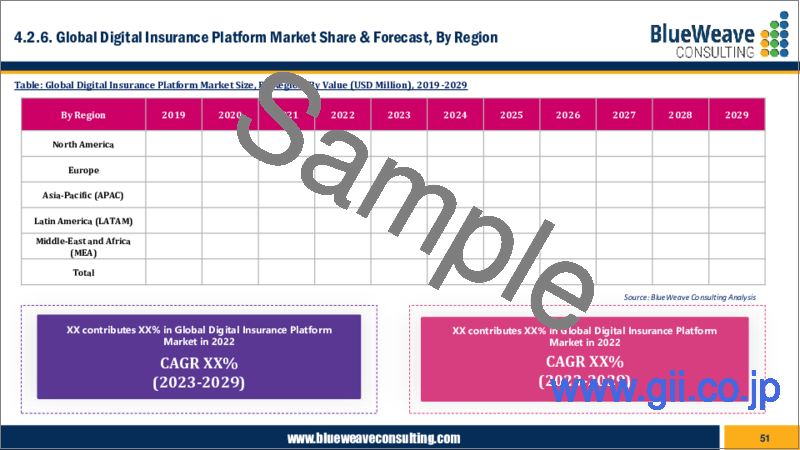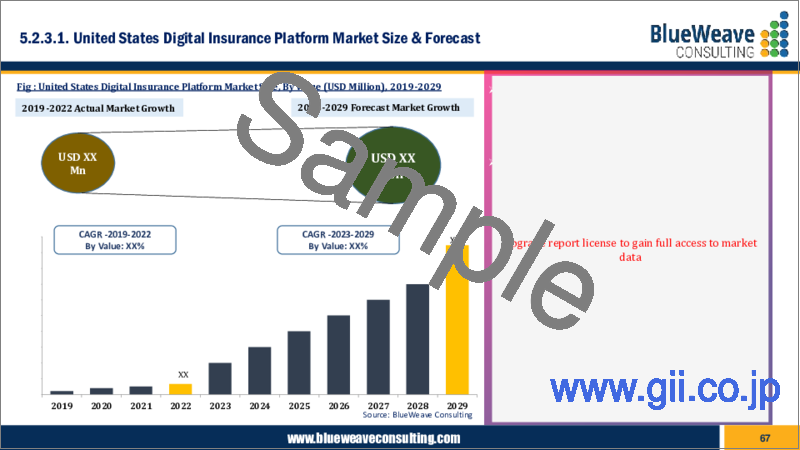|
|
市場調査レポート
商品コード
1359068
デジタル保険プラットフォーム市場- 世界の市場規模、シェア、動向分析、機会、予測レポート、2019-2029年Digital Insurance Platform Market - Global Size, Share, Trend Analysis, Opportunity and Forecast Report, 2019-2029, Segmented By Component ; By Deployment Mode ; By Enterprise Size ; By Application ; By End User ; By Region |
||||||
|
|||||||
| デジタル保険プラットフォーム市場- 世界の市場規模、シェア、動向分析、機会、予測レポート、2019-2029年 |
|
出版日: 2023年09月20日
発行: Blueweave Consulting
ページ情報: 英文 400 Pages
納期: 2~3営業日
|
- 全表示
- 概要
- 目次
デジタル保険プラットフォームの世界市場規模は倍増を超え、2029年までに2,503億米ドルに達します。
世界のデジタル保険プラットフォーム市場は、クラウド技術の採用拡大、効率性と有効性へのニーズの高まり、デジタル・ソリューションの高い採用率などを背景に活況を呈しています。
戦略コンサルティング・市場調査の大手であるBlueWeave Consulting社は、最近の調査で、2022年の世界のデジタル保険プラットフォーム市場規模を1,153億7,000万米ドルと推定しました。2023年から2029年までの予測期間中、世界のデジタル保険プラットフォーム市場規模はCAGR 11.7%という大幅な成長を遂げ、2029年には2,503億米ドルに達するとBlueWeaveは予測しています。世界のデジタル保険プラットフォーム市場の主な成長促進要因としては、さまざまな産業でデジタル化の傾向が強まっていることや、商品中心から消費者中心の戦略に移行する保険会社が増加していることなどが挙げられます。もう1つの原動力は、デジタル保険チャネルの利点に関する世界人口の意識の高まりです。こうしたデジタルを活用することで、保険会社は複雑な基幹システムから、柔軟性、技術的熟練度、革新性、デジタルを使いこなす能力の向上を特徴とするビジネスモデルへと移行することができます。これらのデジタル・チャネルは、保険会社に複雑な基幹システムから、柔軟性、技術的熟練度、革新性、デジタル環境における流暢性の向上を特徴とするビジネス・モデルへの移行を促すものです。特筆すべきは、これらのデジタル・プラットフォームは、処理の迅速化、顧客体験の向上、保険金請求処理の合理化、コミュニケーション・チャネルの改善、保険金請求状況の確認の簡素化など、数多くの利点を提供することです。これらのプラットフォームはまた、保険会社がオンライン・プロセスを通じて保険会社から事前承認を得ることを容易にするため、保険金支払いプロセスにおける遅延を減らし、エラーを最小限に抑えることができます。また、これらのプラットフォームに人工知能(AI)を統合することで、全体的な顧客体験が向上し、クレーム処理時間が短縮され、業界の引受プロセスに変革をもたらしています。しかし、プライバシーとセキュリティに関する懸念と、保険プラットフォームとレガシーシステムとの統合に伴う困難が、分析期間中の市場全体の成長を抑制すると予想されます。
本レポートの詳細な分析により、世界のデジタル保険プラットフォーム市場の成長可能性、今後の動向、統計に関する情報を提供します。また、総市場規模の予測を促進する要因にも注目しています。当レポートは、世界のデジタル保険プラットフォーム市場の最新技術動向や業界考察を提供し、意思決定者が健全な戦略的意思決定を行えるよう支援することをお約束します。さらに、市場の成長促進要因・課題・競争力学についても分析しています。
目次
第1章 調査の枠組み
第2章 エグゼクティブサマリー
第3章 世界デジタル保険プラットフォーム市場洞察
- 業界のバリューチェーン分析
- DROC分析
- 成長促進要因
- デジタルソリューションの採用の増加
- 効率性と効果性に対するニーズの高まり
- クラウド導入の拡大
- 抑制要因
- プライバシーとセキュリティへの懸念
- 保険プラットフォームとレガシーシステムの統合に伴う困難
- 機会
- 市場のより広範なセグメントにアクセスするための保険会社の意識の向上
- 人工知能と高度な分析の採用の拡大
- 課題
- 熟練した労働力の不足
- 規制コンプライアンス
- 成長促進要因
- 技術の進歩/最近の開発
- 規制の枠組み
- ポーターのファイブフォース分析
第4章 世界デジタル保険プラットフォーム市場概要
- 市場規模と予測、2019~2029年
- 金額別
- 市場シェアと予測
- コンポーネント別
- 解決
- サービス
- 導入モード別
- オンプレミス
- クラウド
- 企業規模別
- 大企業
- 中小企業(SME)
- 用途別
- 自動車、輸送、物流
- 生活と健康
- 商業ビルおよび住宅ビル
- ビジネスエンタープライズ
- 農業
- その他
- エンドユーザー別
- 保険会社
- アグリゲータ
- サードパーティの管理者とブローカー
- その他
- 地域別
- 北米
- 欧州
- アジア太平洋(APAC)
- ラテンアメリカ(LATAM)
- 中東およびアフリカ(MEA)
- コンポーネント別
第5章 北米デジタル保険プラットフォーム市場
- 市場規模と予測、2019~2029年
- 金額別
- 市場シェアと予測
- コンポーネント別
- 導入モード別
- 企業規模別
- 用途別
- エンドユーザー別
- 国別
- 米国
- カナダ
第6章 欧州のデジタル保険プラットフォーム市場
- 市場規模と予測、2019~2029年
- 金額別
- 市場シェアと予測
- コンポーネント別
- 導入モード別
- 企業規模別
- 用途別
- エンドユーザー別
- 国別
- ドイツ
- 英国
- イタリア
- フランス
- スペイン
- ベルギー
- ロシア
- オランダ
- その他欧州
第7章 アジア太平洋デジタル保険プラットフォーム市場
- 市場規模と予測、2019~2029年
- 金額別
- 市場シェアと予測
- コンポーネント別
- 導入モード別
- 企業規模別
- 用途別
- エンドユーザー別
- 国別
- 中国
- インド
- 日本
- 韓国
- オーストラリアとニュージーランド
- インドネシア
- マレーシア
- シンガポール
- ベトナム
- APACのその他諸国
第8章 ラテンアメリカのデジタル保険プラットフォーム市場
- 市場規模と予測、2019~2029年
- 金額別
- 市場シェアと予測
- コンポーネント別
- 導入モード別
- 企業規模別
- 用途別
- エンドユーザー別
- 国別
- ブラジル
- メキシコ
- アルゼンチン
- ペルー
- 中南米の残りの地域
第9章 中東およびアフリカのデジタル保険プラットフォーム市場
- 市場規模と予測、2019~2029年
- 金額別
- 市場シェアと予測
- コンポーネント別
- 導入モード別
- 企業規模別
- 用途別
- エンドユーザー別
- 国別
- サウジアラビア
- アラブ首長国連邦
- カタール
- クウェート
- 南アフリカ
- ナイジェリア
- アルジェリア
- MEAの残りの部分
第10章 競合情勢
- 主要企業とその製品のリスト
- 世界デジタル保険プラットフォーム企業の市場シェア分析、2022年
- 経営パラメータによる競合ベンチマーキング
- 主要な戦略的展開(合併、買収、パートナーシップなど)
第11章 世界のデジタル保険プラットフォーム市場に対するCOVID-19の影響
12:企業プロファイル(会社概要、財務マトリックス、競合情勢、主要人材、主要競合、連絡先住所、戦略的展望、 SWOT分析)
- IBM Corporation
- Microsoft Corporation
- Oracle Corporation
- Pegasystems Inc.
- Wipro Limited
- DXC Technology Company
- Appian Corporation
- Mindtree Ltd
- Prima Solutions SA
- Majesco
- EIS Software Limited
- Lemonade Insurance Company
- Majesco
- Oscar Insurance
- OutSystems
- その他の主要企業
第13章 主要な戦略的推奨事項
第14章 調査手法
Global Digital Insurance Platform Market Size More Than Doubles to Touch USD 250.3 Billion by 2029.
Global digital insurance platform market is flourishing because of the growing adoption of cloud technology, an increasing need for efficiency and effectiveness, and high adoption of digital solutions.
BlueWeave Consulting, a leading strategic consulting and market research firm, in its recent study, estimated the global digital insurance platform market size at USD 115.37 billion in 2022. During the forecast period between 2023 and 2029, BlueWeave expects the global digital insurance platform market size to grow at a significant CAGR of 11.7% reaching a value of USD 250.3 billion by 2029. Major growth drivers for the global digital insurance platform market include an increasing trend of digitalization across various industries and growing numbers of insurers shifting from product-centric to consumer-centric strategies. Another driving force is the growing awareness among the global population regarding the advantages of digital insurance channels. These digital avenues empower insurers to transition from complex core systems to a business model characterized by growing flexibility, technical proficiency, innovations, and an increasing fluency in the digital landscape. These digital avenues empower insurers to transition from complex core systems to a business model characterized by growing flexibility, technical proficiency, innovation, and an increasing fluency in the digital landscape. Notably, these digital platforms offer numerous advantages, including accelerated processing, enhanced customer experiences, streamlined claims processing, improved communication channels, and simplified claim status verification. These platforms also facilitate insurers in obtaining pre-approvals from insurance providers through online processes, thus reducing delays and minimizing errors during the claims settlement process. Also, the integration of artificial intelligence (AI) into these platforms enhances the overall customer experience, reduces claim processing times, and brings about transformative changes in the underwriting processes of the industry. However, privacy & security concern and difficulties involved in the integration of insurance platforms with legacy systems are anticipated to restrain the overall market growth during the period in analysis.
Global Digital Insurance Platform Market - Overview:
Digital insurance solutions encompass online platforms and technological tools designed to deliver personalized and efficient insurance services to clients. These digital platforms offer a multitude of advantages compared to traditional insurance systems, notably simplifying coverage. They empower customers with the ability to research, compare, and purchase insurance without the involvement of intermediaries or agents. Importantly, digital insurance platforms enable insurers to craft personalized products, facilitating more precise underwriting and pricing tailored to individual clients. Notably, these platforms excel in fostering meaningful customer engagement across multiple channels, enhancing the overall personalization offered to clients. This, in turn, drives increased adoption of these platforms among customers. Also, the elimination of intermediaries and agents significantly reduces insurance costs. For instance, as per an industry estimate, brokerage fees for term plans can account for up to 30% of the premium. Moreover, there exists a notable difference in premiums when purchasing insurance online versus offline, typically ranging between 5-10%.
Impact of COVID-19 on Global Digital Insurance Platform Market:
COVID-19 pandemic had a positive impact on the global digital insurance platform market. The crisis accelerated the urgency for insurers to adopt digital solutions to meet the evolving needs of remote customers. The pandemic highlighted the importance of contactless interactions, remote policy management, and efficient claims processing. As a result, there was a surge in demand for digital insurance platforms. However, the economic downturn caused by the pandemic also led to cost-cutting measures, affecting some insurance technology investments. Overall, COVID-19 catalyzed digital transformation in the insurance sector, emphasizing the need for agile and tech-driven solutions to navigate unprecedented challenges.
Global Digital Insurance Platform Market - By Application:
Based on application, the global digital insurance platform market is divided into Automotive, Transportation, and Logistics, Life & Health, Commercial & Residential Buildings, Business & Enterprise, and Agriculture segments. The automotive, transportation, and logistics segment holds the highest share in the global digital insurance platform market by application. The segment relies on efficient risk management and claims processing due to the inherent risks involved in vehicle operations and cargo transportation. Digital platforms offer real-time risk assessment, telematics integration, and cost-effective policies, aligning with the industry's demand for streamlined operations and cost savings. Customization, compliance support, and global reach further enhance the appeal of digital solutions, making them the preferred choice for businesses in this sector seeking effective risk mitigation and insurance management.
Competitive Landscape:
Major players operating in the global digital insurance platform market include: IBM Corporation, Microsoft Corporation, Oracle Corporation, Pegasystems Inc., Wipro Limited, DXC Technology Company, Appian Corporation, Mindtree Ltd, Prima Solutions SA, Majesco, EIS Software Limited, Lemonade Insurance Company, Oscar Insurance, and OutSystems. To further enhance their market share, these companies employ various strategies, including mergers and acquisitions, partnerships, joint ventures, license agreements, and new product launches.
The in-depth analysis of the report provides information about growth potential, upcoming trends, and statistics of Global Digital Insurance Platform Market. It also highlights the factors driving forecasts of total market size. The report promises to provide recent technology trends in Global Digital Insurance Platform Market and industry insights to help decision-makers make sound strategic decisions. Furthermore, the report also analyzes the growth drivers, challenges, and competitive dynamics of the market.
Table of Contents
1. Research Framework
- 1.1. Research Objective
- 1.2. Product Overview
- 1.3. Market Segmentation
2. Executive Summary
3. Global Digital Insurance Platform Market Insights
- 3.1. Industry Value Chain Analysis
- 3.2. DROC Analysis
- 3.2.1. Growth Drivers
- 3.2.1.1. Increasing adoption of digital solutions
- 3.2.1.2. Rising Need for Efficiency and Effectiveness
- 3.2.1.3. Growing cloud adoption
- 3.2.2. Restraints
- 3.2.2.1. Privacy & security concern
- 3.2.2.2. Difficulties involved in the integration of insurance platforms with legacy systems
- 3.2.3. Opportunities
- 3.2.3.1. Increasing awareness amongst insurers to access a broader segment of the market
- 3.2.3.2. Growing adoption of artificial intelligence and advanced analytics
- 3.2.4. Challenges
- 3.2.4.1. Dearth of skilled workforce
- 3.2.4.2. Regulatory compliance
- 3.2.1. Growth Drivers
- 3.3. Technological Advancements/Recent Developments
- 3.4. Regulatory Framework
- 3.5. Porter's Five Forces Analysis
- 3.5.1. Bargaining Power of Suppliers
- 3.5.2. Bargaining Power of Buyers
- 3.5.3. Threat of New Entrants
- 3.5.4. Threat of Substitutes
- 3.5.5. Intensity of Rivalry
4. Global Digital Insurance Platform Market Overview
- 4.1. Market Size & Forecast, 2019-2029
- 4.1.1. By Value (USD Million)
- 4.2. Market Share & Forecast
- 4.2.1. By Component
- 4.2.1.1. Solution
- 4.2.1.2. Service
- 4.2.2. By Deployment Mode
- 4.2.2.1. On-premises
- 4.2.2.2. Cloud
- 4.2.3. By Enterprise Size
- 4.2.3.1. Large Enterprises
- 4.2.3.2. Small & Medium-sized Enterprises (SMEs)
- 4.2.4. By Application
- 4.2.4.1. Automotive, Transportation & Logistics
- 4.2.4.2. Life & Health
- 4.2.4.3. Commercial & Residential Buildings
- 4.2.4.4. Business & Enterprise
- 4.2.4.5. Agriculture
- 4.2.4.6. Others
- 4.2.5. By End User
- 4.2.5.1. Insurance Companies
- 4.2.5.2. Aggregators
- 4.2.5.3. Third-Party Administrators & Brokers
- 4.2.5.4. Others
- 4.2.6. By Region
- 4.2.6.1. North America
- 4.2.6.2. Europe
- 4.2.6.3. Asia Pacific (APAC)
- 4.2.6.4. Latin America (LATAM)
- 4.2.6.5. Middle East and Africa (MEA)
- 4.2.1. By Component
5. North America Digital Insurance Platform Market
- 5.1. Market Size & Forecast, 2019-2029
- 5.1.1. By Value (USD Million)
- 5.2. Market Share & Forecast
- 5.2.1. By Component
- 5.2.2. By Deployment Mode
- 5.2.3. By Enterprise Size
- 5.2.4. By Application
- 5.2.5. By End User
- 5.2.6. By Country
- 5.2.6.1. United States
- 5.2.6.1.1. By Component
- 5.2.6.1.2. By Deployment Mode
- 5.2.6.1.3. By Enterprise Size
- 5.2.6.1.4. By Application
- 5.2.6.1.5. By End User
- 5.2.6.2. Canada
- 5.2.6.2.1. By Component
- 5.2.6.2.2. By Deployment Mode
- 5.2.6.2.3. By Enterprise Size
- 5.2.6.2.4. By Application
- 5.2.6.2.5. By End User
6. Europe Digital Insurance Platform Market
- 6.1. Market Size & Forecast, 2019-2029
- 6.1.1. By Value (USD Million)
- 6.2. Market Share & Forecast
- 6.2.1. By Component
- 6.2.2. By Deployment Mode
- 6.2.3. By Enterprise Size
- 6.2.4. By Application
- 6.2.5. By End User
- 6.2.6. By Country
- 6.2.6.1. Germany
- 6.2.6.1.1. By Component
- 6.2.6.1.2. By Deployment Mode
- 6.2.6.1.3. By Enterprise Size
- 6.2.6.1.4. By Application
- 6.2.6.1.5. By End User
- 6.2.6.2. United Kingdom
- 6.2.6.2.1. By Component
- 6.2.6.2.2. By Deployment Mode
- 6.2.6.2.3. By Enterprise Size
- 6.2.6.2.4. By Application
- 6.2.6.2.5. By End User
- 6.2.6.3. Italy
- 6.2.6.3.1. By Component
- 6.2.6.3.2. By Deployment Mode
- 6.2.6.3.3. By Enterprise Size
- 6.2.6.3.4. By Application
- 6.2.6.3.5. By End User
- 6.2.6.4. France
- 6.2.6.4.1. By Component
- 6.2.6.4.2. By Deployment Mode
- 6.2.6.4.3. By Enterprise Size
- 6.2.6.4.4. By Application
- 6.2.6.4.5. By End User
- 6.2.6.5. Spain
- 6.2.6.5.1. By Component
- 6.2.6.5.2. By Deployment Mode
- 6.2.6.5.3. By Enterprise Size
- 6.2.6.5.4. By Application
- 6.2.6.5.5. By End User
- 6.2.6.6. Belgium
- 6.2.6.6.1. By Component
- 6.2.6.6.2. By Deployment Mode
- 6.2.6.6.3. By Enterprise Size
- 6.2.6.6.4. By Application
- 6.2.6.6.5. By End User
- 6.2.6.7. Russia
- 6.2.6.7.1. By Component
- 6.2.6.7.2. By Deployment Mode
- 6.2.6.7.3. By Enterprise Size
- 6.2.6.7.4. By Application
- 6.2.6.7.5. By End User
- 6.2.6.8. The Netherlands
- 6.2.6.8.1. By Component
- 6.2.6.8.2. By Deployment Mode
- 6.2.6.8.3. By Enterprise Size
- 6.2.6.8.4. By Application
- 6.2.6.8.5. By End User
- 6.2.6.9. Rest of Europe
- 6.2.6.9.1. By Component
- 6.2.6.9.2. By Deployment Mode
- 6.2.6.9.3. By Enterprise Size
- 6.2.6.9.4. By Application
- 6.2.6.9.5. By End User
7. Asia-Pacific Digital Insurance Platform Market
- 7.1. Market Size & Forecast, 2019-2029
- 7.1.1. By Value (USD Million)
- 7.2. Market Share & Forecast
- 7.2.1. By Component
- 7.2.2. By Deployment Mode
- 7.2.3. By Enterprise Size
- 7.2.4. By Application
- 7.2.5. By End User
- 7.2.6. By Country
- 7.2.6.1. China
- 7.2.6.1.1. By Component
- 7.2.6.1.2. By Deployment Mode
- 7.2.6.1.3. By Enterprise Size
- 7.2.6.1.4. By Application
- 7.2.6.1.5. By End User
- 7.2.6.2. India
- 7.2.6.2.1. By Component
- 7.2.6.2.2. By Deployment Mode
- 7.2.6.2.3. By Enterprise Size
- 7.2.6.2.4. By Application
- 7.2.6.2.5. By End User
- 7.2.6.3. Japan
- 7.2.6.3.1. By Component
- 7.2.6.3.2. By Deployment Mode
- 7.2.6.3.3. By Enterprise Size
- 7.2.6.3.4. By Application
- 7.2.6.3.5. By End User
- 7.2.6.4. South Korea
- 7.2.6.4.1. By Component
- 7.2.6.4.2. By Deployment Mode
- 7.2.6.4.3. By Enterprise Size
- 7.2.6.4.4. By Application
- 7.2.6.4.5. By End User
- 7.2.6.5. Australia & New Zealand
- 7.2.6.5.1. By Component
- 7.2.6.5.2. By Deployment Mode
- 7.2.6.5.3. By Enterprise Size
- 7.2.6.5.4. By Application
- 7.2.6.5.5. By End User
- 7.2.6.6. Indonesia
- 7.2.6.6.1. By Component
- 7.2.6.6.2. By Deployment Mode
- 7.2.6.6.3. By Enterprise Size
- 7.2.6.6.4. By Application
- 7.2.6.6.5. By End User
- 7.2.6.7. Malaysia
- 7.2.6.7.1. By Component
- 7.2.6.7.2. By Deployment Mode
- 7.2.6.7.3. By Enterprise Size
- 7.2.6.7.4. By Application
- 7.2.6.7.5. By End User
- 7.2.6.8. Singapore
- 7.2.6.8.1. By Component
- 7.2.6.8.2. By Deployment Mode
- 7.2.6.8.3. By Enterprise Size
- 7.2.6.8.4. By Application
- 7.2.6.8.5. By End User
- 7.2.6.9. Vietnam
- 7.2.6.9.1. By Component
- 7.2.6.9.2. By Deployment Mode
- 7.2.6.9.3. By Enterprise Size
- 7.2.6.9.4. By Application
- 7.2.6.9.5. By End User
- 7.2.6.10. Rest of APAC
- 7.2.6.10.1. By Component
- 7.2.6.10.2. By Deployment Mode
- 7.2.6.10.3. By Enterprise Size
- 7.2.6.10.4. By Application
- 7.2.6.10.5. By End User
8. Latin America Digital Insurance Platform Market
- 8.1. Market Size & Forecast, 2019-2029
- 8.1.1. By Value (USD Million)
- 8.2. Market Share & Forecast
- 8.2.1. By Component
- 8.2.2. By Deployment Mode
- 8.2.3. By Enterprise Size
- 8.2.4. By Application
- 8.2.5. By End User
- 8.2.6. By Country
- 8.2.6.1. Brazil
- 8.2.6.1.1. By Component
- 8.2.6.1.2. By Deployment Mode
- 8.2.6.1.3. By Enterprise Size
- 8.2.6.1.4. By Application
- 8.2.6.1.5. By End User
- 8.2.6.2. Mexico
- 8.2.6.2.1. By Component
- 8.2.6.2.2. By Deployment Mode
- 8.2.6.2.3. By Enterprise Size
- 8.2.6.2.4. By Application
- 8.2.6.2.5. By End User
- 8.2.6.3. Argentina
- 8.2.6.3.1. By Component
- 8.2.6.3.2. By Deployment Mode
- 8.2.6.3.3. By Enterprise Size
- 8.2.6.3.4. By Application
- 8.2.6.3.5. By End User
- 8.2.6.4. Peru
- 8.2.6.4.1. By Component
- 8.2.6.4.2. By Deployment Mode
- 8.2.6.4.3. By Enterprise Size
- 8.2.6.4.4. By Application
- 8.2.6.4.5. By End User
- 8.2.6.5. Rest of LATAM
- 8.2.6.5.1. By Component
- 8.2.6.5.2. By Deployment Mode
- 8.2.6.5.3. By Enterprise Size
- 8.2.6.5.4. By Application
- 8.2.6.5.5. By End User
9. Middle East & Africa Digital Insurance Platform Market
- 9.1. Market Size & Forecast, 2019-2029
- 9.1.1. By Value (USD Million)
- 9.2. Market Share & Forecast
- 9.2.1. By Component
- 9.2.2. By Deployment Mode
- 9.2.3. By Enterprise Size
- 9.2.4. By Application
- 9.2.5. By End User
- 9.2.6. By Country
- 9.2.6.1. Saudi Arabia
- 9.2.6.1.1. By Component
- 9.2.6.1.2. By Deployment Mode
- 9.2.6.1.3. By Enterprise Size
- 9.2.6.1.4. By Application
- 9.2.6.1.5. By End User
- 9.2.6.2. UAE
- 9.2.6.2.1. By Component
- 9.2.6.2.2. By Deployment Mode
- 9.2.6.2.3. By Enterprise Size
- 9.2.6.2.4. By Application
- 9.2.6.2.5. By End User
- 9.2.6.3. Qatar
- 9.2.6.3.1. By Component
- 9.2.6.3.2. By Deployment Mode
- 9.2.6.3.3. By Enterprise Size
- 9.2.6.3.4. By Application
- 9.2.6.3.5. By End User
- 9.2.6.4. Kuwait
- 9.2.6.4.1. By Component
- 9.2.6.4.2. By Deployment Mode
- 9.2.6.4.3. By Enterprise Size
- 9.2.6.4.4. By Application
- 9.2.6.4.5. By End User
- 9.2.6.5. South Africa
- 9.2.6.5.1. By Component
- 9.2.6.5.2. By Deployment Mode
- 9.2.6.5.3. By Enterprise Size
- 9.2.6.5.4. By Application
- 9.2.6.5.5. By End User
- 9.2.6.6. Nigeria
- 9.2.6.6.1. By Component
- 9.2.6.6.2. By Deployment Mode
- 9.2.6.6.3. By Enterprise Size
- 9.2.6.6.4. By Application
- 9.2.6.6.5. By End User
- 9.2.6.7. Algeria
- 9.2.6.7.1. By Component
- 9.2.6.7.2. By Deployment Mode
- 9.2.6.7.3. By Enterprise Size
- 9.2.6.7.4. By Application
- 9.2.6.7.5. By End User
- 9.2.6.8. Rest of MEA
- 9.2.6.8.1. By Component
- 9.2.6.8.2. By Deployment Mode
- 9.2.6.8.3. By Enterprise Size
- 9.2.6.8.4. By Application
- 9.2.6.8.5. By End User
10. Competitive Landscape
- 10.1. List of Key Players and Their Offerings
- 10.2. Global Digital Insurance Platform Company Market Share Analysis, 2022
- 10.3. Competitive Benchmarking, By Operating Parameters
- 10.4. Key Strategic Developments (Mergers, Acquisitions, Partnerships, etc.)
11. Impact of Covid-19 on Global Digital Insurance Platform Market
12. Company Profile (Company Overview, Financial Matrix, Competitive Landscape, Key Personnel, Key Competitors, Contact Address, Strategic Outlook, SWOT Analysis)
- 12.1. IBM Corporation
- 12.2. Microsoft Corporation
- 12.3. Oracle Corporation
- 12.4. Pegasystems Inc.
- 12.5. Wipro Limited
- 12.6. DXC Technology Company
- 12.7. Appian Corporation
- 12.8. Mindtree Ltd
- 12.9. Prima Solutions SA
- 12.10. Majesco
- 12.11. EIS Software Limited
- 12.12. Lemonade Insurance Company
- 12.13. Majesco
- 12.14. Oscar Insurance
- 12.15. OutSystems
- 12.16. Other Prominent Players
13. Key Strategic Recommendations
14. Research Methodology
- 14.1. Qualitative Research
- 14.1.1. Primary & Secondary Research
- 14.2. Quantitative Research
- 14.3. Market Breakdown & Data Triangulation
- 14.3.1. Secondary Research
- 14.3.2. Primary Research
- 14.4. Breakdown of Primary Research Respondents, By Region
- 14.5. Assumptions & Limitations






